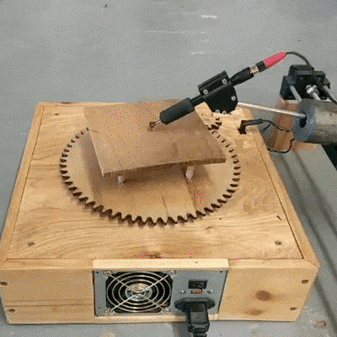With CNC machines, generally the more axes the better. Three-axis machines with a vertical quill over a rectangular workspace are de rigueur, and adding an axis or two can really step up the flexibility of a machine. But can only two axes be of any use? Sure can, as witnessed by this two-axis CNC wood burning machine.
 As [tuckershannon] tells the tale, this was a newbie build aided by the local hackerspace. Axis one is a rotary table of laser-cut wood gears powered by a stepper. Axis two is just a stepper and lead screw sitting on a couple of blocks of wood. A Raspberry Pi under the hood controls the motors and cycles the pyrography pen on and off as it scans across a piece of wood on the rotary table, burning a spiral pattern that makes for some interesting art. Hats off to [tuckershannon] for figuring out the math needed to adapt to the changing speed of the pen over the wood as the diameter gets bigger.
As [tuckershannon] tells the tale, this was a newbie build aided by the local hackerspace. Axis one is a rotary table of laser-cut wood gears powered by a stepper. Axis two is just a stepper and lead screw sitting on a couple of blocks of wood. A Raspberry Pi under the hood controls the motors and cycles the pyrography pen on and off as it scans across a piece of wood on the rotary table, burning a spiral pattern that makes for some interesting art. Hats off to [tuckershannon] for figuring out the math needed to adapt to the changing speed of the pen over the wood as the diameter gets bigger.
We love this build, can’t help but wonder if some clever gearing could eliminate the need for the second stepper. And perhaps an upgrade from the standard resistive wood burner to an arc lighter pyrography pen would improve resolution. Still, it’s hard to argue with results, and this is a great hack.
[via r/raspberrypi]
Thanks to [Liz] for the tip!
















> But can only two axes be of any use? Sure can, as witnessed by…
lathes.
It’s really three axes still. Rotation. Longitudinal and up/down of the tool. Otherwise, it would be good at making a black circle.
Don’t we refer to pen plotters as having 2 axes, despite having the same up/down switch that this does?
Asking google I see roughly a tie between people thinking they’ve 2 or 3 axes.
Maybe you can refer to it as 2.5D like they do with cnc routers and mills.
So why why would this have an advantage over, say, a two axis laser engraver?
……Price?
Hardly. You still need two stepper motors and a micro controller. A laser module powerful enough to burn wood is sub £50 these days (a pyrography pen can’t be much cheaper). What’s the advantage?
Soldering irons can be really cheap. You could even create one with a 3d printer heater cartridge and a metal mass ending in a flattened tip.
Speaking of 3d printers, you could just use the heated nozzle without filament and mount the wood on the bed. Vary the speed for shading. Auto bed leveling should make it easy.
Foot print, for whatever that’s worth. The available area is a function of the square of the radius, so as long as a circle is an ok target, doubling the length of one axis (the other is effectively infinite) means 4 times the working area. In an X-Y one would have to double the lengths of both axes to get the same change.
Is that a picture of the World Tree burnt on to the wood? (Sorry I can’t spell Yggdrasil.)
This is now the third 2 axis machine I’ve seen. Pretty cool!